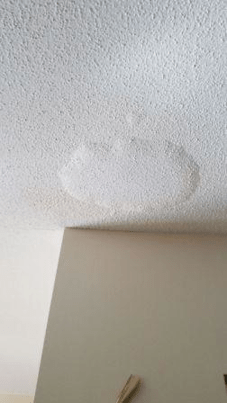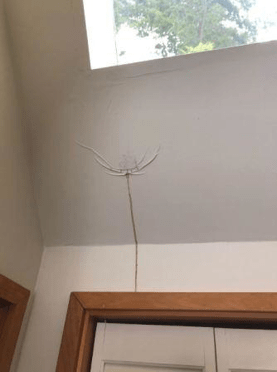Water damage is an extremely common cause of property damage, second only to wind and hail. The Insurance Information Institute (iii) reports that 36% of property damage claims are caused by water and freeze damage. "About one in 50 insured homes has a property damage claim caused by water damage or freezing each year" (iii.org). You may not notice there is an issue until you see a dark brown stain on the ceiling. Unfortunately, the longer water sits unchecked, the more damage it can cause. This guide provides you with tips on how to find and prevent a water leak in your ceiling.
What Causes a Ceiling Leak?
Consider what is located above the leak. If the ceiling in question is on the top floor, you are most likely looking at a roof leak. If there is a bathroom or kitchen above the ceiling then you probably have a plumbing problem. Keep in mind that water does not always travel straight down. It can seep into other areas, spreading outward from the source. This can make it difficult to determine where the initial water intrusion is coming from.
Plumbing Issues
- Bathrooms use the most water in your home. Between the sink, bathtub, shower, and toilet, there are a lot of pipes and the potential for a leak is high.
- Pipe breaks are the most common cause of water damage. Water lines running to your appliances like refrigerators, dishwashers, and washing machines are a common culprit.
- When the temperatures drop in the winter, we often receive calls for frozen pipe bursts. When the water in the pipe freezes, it expands causing a crack that water will flow from when the ice melts.
Appliance or fixture overflows
- Sinks, toilets, and bathtubs left to run or unresolved clogs are common. You can find more tips for surviving a sewage backup here.
- Air conditioning units located in the attic can leak when the drain line gets clogged. If left unchecked, the drain pan will overflow and leak water down into your home.
- Missing caulking around a sink, bathtub, or window allows the water to travel down to the ceiling below.
Roof Leaks
- Time and weather can take their toll on a home's roof. Common causes of water damage from a roof are missing shingles from a high wind storm, worn flashing, or cracked mortar on your chimney.
- Ice dam build-up on your roof's edges can cause the water to back up and leak into the home.
- Routine inspection of your house throughout the summer storm season and heavy winter snowfalls will help you to locate damage quickly.
Signs of Ceiling Water Damage



These photos show examples of ceiling water damage we have encountered during our restoration services.
- Dark or wet spots on the wall or ceiling.
- Drywall or plaster that shows cracks or flaking.
- Wet spots, drips, or puddles around your plumbing.
- Water dripping from your ceiling.
- An increase in humidity in the home that is not attributed to the weather.
- A damp, musty smell.
- The sound of running water even when all the fixtures are turned off.
- A spike in your water bill could indicate a hidden leak.
What to do if you find water damage
- Stop the source of the water to prevent any more damage. If you have a plumbing or appliance leak, turn off the water valve to the fixture or appliance. If you can't find the unit's water valve, turn off the water at the main shut-off for the house. If you have a roof leak, you will need to call a professional roofer or an emergency board-up company to stop the water from coming in.
- Turn off the electricity to any rooms with standing water.
- Soak up as much excess water as you can with towels or mops.
- Prop up furniture and belongings to keep them from wicking up water. You can also use aluminum foil for this.
- Photograph any damage and report the loss to your insurance agent.
- Call ServiceMaster Dynamic Cleaning for professional water damage mitigation.
Recognizing the sources of ceiling water damage is the first step to taking control of the situation. If you experience a ceiling leak in your home, contact us for water restoration services. Our team is available 24/7 at (800) 865-5157.
Click Below to Review Our Water Damage Checklist. 
